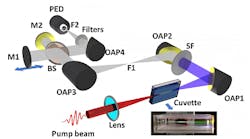Another high-power terahertz laser created from plasma in a liquid
In technology similar to that reported by researchers at the University of Rochester and supporting groups, scientists at the Tata Institute of Fundamental Research (TIFR; Mumbai, India) have devised a high-power terahertz radiation source in collaboration with laboratories in Greece and France, as described in the journal Nature Communications (https://www.nature.com/articles/s41467-017-01382-x).
RELATED ARTICLE: Femtosecond laser pulses produce ultrafast terahertz radiation from water
While there are many sources across the entire electromagnetic spectrum, the terahertz region (wedged between the infrared/optical and the microwave regions) has been a challenge and it is only in the last twenty years that sources have started becoming available. High-power terahertz radiation has typically been available from large, complex machines like free-electron lasers. But compact terahertz sources, relying on semiconductor antennas and special crystals excited by visible/infrared femtosecond laser pulses, have very limited energy outputs, typically in the nanojoule (billionth of a joule) level or lower and are not useful for many applications. High-power femtosecond lasers have however, excited terahertz emission that are a thousand times larger (microjoules) from a plasma formed in air, under special conditions.
For a long time, researchers in this area have believed that liquids could not give out significant terahertz radiation, because they would efficiently reabsorb whatever was generated. Yet, this is where the TIFR researchers proved successful. In their experiments, they irradiated common laboratory liquids like methanol, acetone, dicholorethane, carbon disulphide and even water with moderate energy femtosecond laser pulses, ionizing the liquid and forming long plasma channels called filaments. To their delight they measured energies as high as 50 microjoules, thousands of times larger than the energies emitted by most existing sources and 10‐20 times larger than those produced from air.
Their careful characterization and systematic study showed that the experimental conditions were simpler than those needed for air. The mechanism that facilitates the large output (in spite of the deleterious absorption) has emerged from models used by their theoretical collaborators from the Institute of Electronic Structure and Laser, Foundation for Research and Technology Hellas, Greece and Ecole Polytechnique, Paris. The essence of this model is that the femtosecond laser pulse induces secondary emissions in the liquid which would then combine with the incident laser pulse to produce the observed terahertz radiation.
The TIFR researchers (Prof. G. Ravindra Kumar, Dr. Indranuj Dey and colleagues) are bullish about the applications of their liquid source, the brightest among compact, tabletop sources. They foresee many applications in terahertz imaging, material analysis, explosive detection and terahertz nonlinear optics.
SOURCE: TIFR via EurekAlert!; http://www.tifr.res.in/TSN/article/GRK-Eurekalert%20release-26Oct%202017%20FINAL-%20for%20TIFR%20webpage%202017Oct30.pdf
About the Author

Gail Overton
Senior Editor (2004-2020)
Gail has more than 30 years of engineering, marketing, product management, and editorial experience in the photonics and optical communications industry. Before joining the staff at Laser Focus World in 2004, she held many product management and product marketing roles in the fiber-optics industry, most notably at Hughes (El Segundo, CA), GTE Labs (Waltham, MA), Corning (Corning, NY), Photon Kinetics (Beaverton, OR), and Newport Corporation (Irvine, CA). During her marketing career, Gail published articles in WDM Solutions and Sensors magazine and traveled internationally to conduct product and sales training. Gail received her BS degree in physics, with an emphasis in optics, from San Diego State University in San Diego, CA in May 1986.
